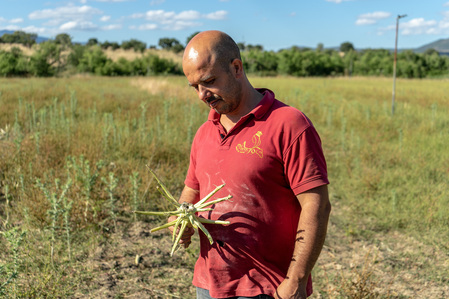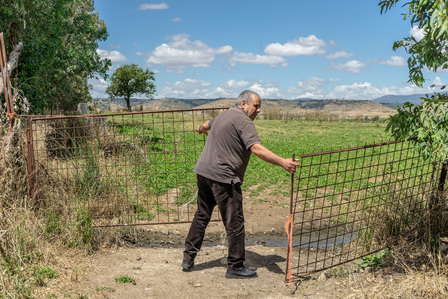Click here to read the full reportage, for CGTN Europe [English version]
Click here to read the full reportage for Reporterre [French version] and La Nuova Ecologia [Italian version]
ENG
Since the end of April 2020, a locust invasion has been affecting the valley of the river Tirso, in central Sardinia. The insects, commonly known as Moroccan locusts, have devastated vegetable gardens, fields, grasslands, and invaded houses and gardens, covering an area of 20-25,000 hectares. Locusts had already appeared last summer in the same area, but the extent of the damage has increased tenfold in just one year. This is unimaginable loss for the communities in the site: on average, 60% of the crops were devastated.
The farmers found their fields completely emptied, while the shepherds - deprived of their grasslands - had to buy bales of hay to feed their flocks. But this is not a new phenomenon on the Mediterranean island. Invasions of this parasite have succeeded one another over the centuries, forcing the local population to use - especially in the first half of the last century - every means to fight them: from arsenic to flamethrowers, and even relying on the miracles of Saint Narcissus, patron saint of peasants and herdsmen.
From the 1940s the invasions gradually waned thanks, above all, to agricultural mechanization. The increase in cultivated land meant less space for the proliferation of locusts, which lay eggs in soil and require it to be undisturbed for their incubation period to reproduce. In recent years, however, rising temperatures, climate trends and the progressive depopulation of Sardinia's inland countryside, has turned the trend. The bizarre and particularly dry weather conditions of last years have been predisposing factors that has favored this phenomenon.
ITA
Dalla fine di aprile 2020, un'invasione di locuste sta colpendo la valle del fiume Tirso, nella Sardegna centrale. Gli insetti, comunemente noti come locuste del Marocco, hanno devastato orti, campi, praterie e invaso case e giardini, interessando una superficie di circa 25.000 ettari. Le locuste erano già apparse l'estate scorsa nella stessa zona, ma l'entità dei danni è decuplicata in un solo anno. Una perdita inimmaginabile per le comunità locali: in media, il 60% delle colture è stato devastato.
Questo non è però un fenomeno nuovo nell'isola. Le invasioni di questo parassita si sono succedute nei secoli, costringendo la popolazione locale a utilizzare - soprattutto nella prima metà del secolo scorso - ogni mezzo per combatterle: dall'arsenico ai lanciafiamme, fino alle preghiere rivolte a San Narciso, patrono dei contadini e dei pastori. Dagli anni Quaranta le invasioni si sono gradualmente affievolite grazie soprattutto alla meccanizzazione agricola: l'aumento dei terreni coltivati significava meno spazio per la proliferazione delle locuste, che depongono le uova nel terreno e che necessitano di essere indisturbate per il loro periodo di incubazione per riprodursi.
Negli ultimi anni, però, l'aumento delle temperature, l'andamento climatico e il progressivo spopolamento delle campagne interne hanno invertito la tendenza. Le condizioni climatiche particolarmente secche e altalenanti degli ultimi anni sono state fattori predisponenti che hanno favorito questo fenomeno.














